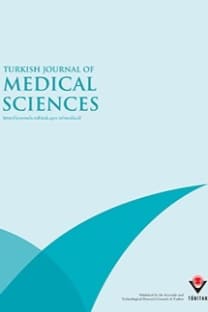A comparison of the treatment of DDH in the older children by femoral shortening with a) acetabular shelf and b) innominate osteotomy plus shelf
Key words: Developmental dislocation of the hip, delayed diagnosis, acetabuloplasty techniques
A comparison of the treatment of DDH in the older children by femoral shortening with a) acetabular shelf and b) innominate osteotomy plus shelf
Key words: Developmental dislocation of the hip, delayed diagnosis, acetabuloplasty techniques,
___
- 1. Berkeley ME, Dickson JH, Cain TE, Donovan MM. Surgical therapy for congenital dislocation of the hip in patients who are twelve to thirty-six months old. J Bone Joint Surg Am. 1984 Mar; 66(3): 412-20.
- 2. Dimitriou JK, Cavadias AX. One-stage surgical procedure for congenital dislocation of the hip in older children. Clin Orthop 1989 Sep ; (246): 30-8.
- 3. Karakas ES, Baktir A, Argun M, Turk CY. One stage treatment of congenital dislocation of the hip in older children. J Pediatr Orthop 1995 May-Jun; 15(3): 330-6.
- 4. MacEwen GD. Treatment of congenital dislocation of the hip in older children. Clin Orthop 1987 Dec; (225): 86-92.
- 5. Massie WK, Howorth MB. Congenital dislocation of the hip. Part II. Results of open reduction as seen in early adult period. J Bone Joint Surg (Am) 1951; 33: 171-90.
- 6. Severin E. Congenital dislocation of the hip: development of the joint after closed reduction. J Bone Joint Surg (Am) 1950; 32-A: 507-18.
- 7. Tükenmez M, Perçin S, Tezeren G, Cingöz MA, The outcomes of salter innominate osteotomy in the treatment of developmental dysplasia of the hip. Turkiye Klinikleri J Med Sci 2006; 26(4): 390-95.
- 8. Ryan MG, Johnson LO, Quanbeck DS, Minkowitz B. Onestage treatment of congenital dislocation of the hip in children three to ten years old. Functional and radiographic results. J Bone Joint Surg (Am) 1998; 80: 336-44.
- 9. Boyer DW, Mickelson MR, Ponseti IV. Slipped capital femoral epiphysis. Long-termfollow-up study of one hundred and twenty-one patients. J Bone Joint Surg (Am) 1981; 63: 85-95.
- 10. Williamson DM, Glover SD, Benson MK. Congenital dislocation of the hip presenting after the age of three years. A long-term review. J Bone Joint Surg (Br) 1989; 71: 745-51.
- 11. Barrett WP, Staheli LT, Chew DE. The effectiveness of the Salter innominate osteotomy inthe treatment of congenital dislocation of the hip. J Bone Joint Surg (Am) 1986; 68-A: 79-87.
- 12. Dogan M, Bozkurt M, Sesen H, Yildirim H. One stage treatment of congenital severely dislocated hips in older children through various acetabuloplasty techniques: 22 children followed for 1-5 years. Acta Orthop 2005; Apr; 76(2): 212-9.
- 13. Kalamchi A, MacEven GD. Avascular necrosis following treatment of congenital dislocation of the hip. J Bone Joint Surg (Am) 1980; 62: 876-88.
- 14. Kinik H, Mergen E, Radical reduction for developmental dislocation of the hip (Çakırgil’s procedure). Acta Orthop Traumatol Turc 2007; 41, Suppl 1; 47-53.
- 15. Tönnis D. Normal values of the hip joint for the evaluation of xrays in children and adults. Clin Orthop 1976 Sep; (119): 39- 47.
- 16. Wiberg G. Shelf operation in congenital dysplasia of the acetabulum and in subluxation and dislocation of the hip. J Bone Joint Surg (Am) 1953; 35-A: 65-80.
- 17. Tomak Y, Dabak N, Tilki K, Gülman B, Karaismailoğlu TN, The complıcatıons of open reductıon and salter ınnomınate osteotomy ın the treatment of developmental dıslocatıon of the hıp. Joint Diseases and Related Surgery 2000; 11(2): 162-168
- 18. Galpin RD, Roach JW, Wenger DR, Herring JA, Birch JG. Onestage treatment of congenital dislocation of the hip in older children, including femoral shortening. J Bone Joint Surg (Am) 1989; 71: 734-41.
- 19. Subasi M, Arslan H, Cebesoy O, Buyukbebeci O, Kapukaya A. Outcome unilateral or bilateral DDH treated with one-stage combined procedure. Clin Orthop 2008Apr; 466(4): 830-6
- ISSN: 1300-0144
- Yayın Aralığı: 6
- Yayıncı: TÜBİTAK
Ali YEGİNSU, Makbule ERGİN, Hüseyin ÖZYURT, Çiğdem ELMAS, Güleser ÇAĞLAR GÖKTAŞ
Underlying diseases of recurrent pneumonia in Turkish children*
Osman ÖZDEMİR, Sinan SARI, Arzu BAKIRTAŞ, Pelin ZORLU, Ülker ERTAN
Ali SIZLAN, Uğur GÖKTAŞ, Ceyda ÖZHAN, Mehmet Özgür ÖZHAN, Mehmet Emin ORHAN, Ercan KURT
Emrah ŞENEL, H. Tuğrul TİRYAKİ, Fatih AKBIYIK, Halil ATAYURT
Güedal YILMAZ, İftihar KÖKSAL, Tevfik ÖZLÜ, Savaş ÖZSU
Belgüzar KARA, Cengiz Han AÇIKEL
Alpaslan APAN, Filiz SARI, Alp Burak EKMEKÇİ
Alpaslan APAN, Filiz SARI, Alp Burak EKMEKÇİ
Investigation of the causative agents for community-acquired pneumonia in adult patients
